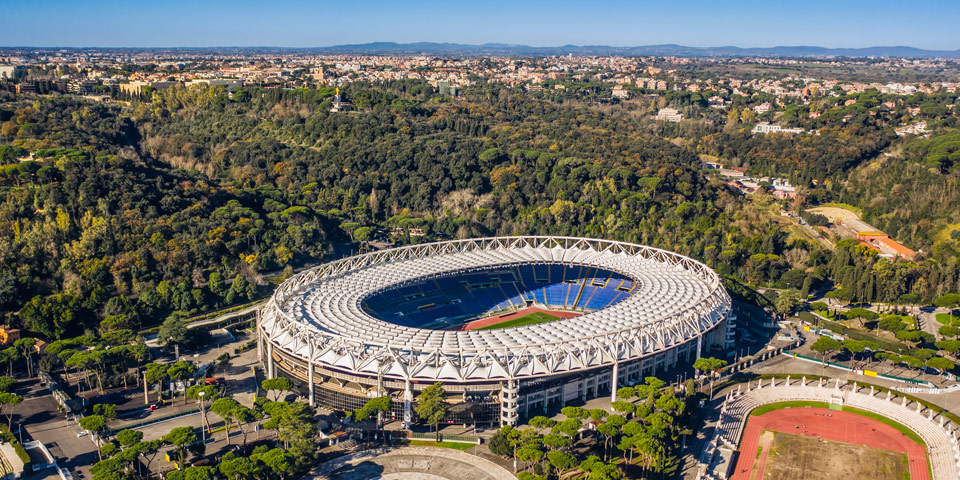

24828 views

| Opening Hours |
Sunday:
-
Monday:
-
Tuesday:
-
Wednesday:
-
Thursday:
-
Friday:
-
Saturday:
-
|
|---|---|
| Recommended tour | |
| Closest bus stops |
|
| Closest subway stations | |
| Address | Viale dei Gladiatori, 2, Roma |
The Olympic Stadium (Stadio Olimpico) is a renowned sports stadium in Rome, Italy. It is a historic venue that has hosted numerous international football matches and events, including the 1990 FIFA World Cup. With a seating capacity of over 70,000 spectators, it stands as one of the largest sports arenas in Italy and is home to both A.S. Roma and S.S. Lazio, two of the country’s top football clubs.
Contents
ToggleThe Olympic Stadium has a rich and storied history. Initially built in 1937 and known as the Stadio dei Cipressi, it was primarily used for athletics events.
The stadium underwent a significant renovation in preparation for the 1960 Summer Olympics, after which it was officially named the Stadio Olimpico. This transformation included expanding its capacity and enhancing its facilities, making it suitable for various sports, including football.
One of the most iconic moments in the Stadio Olimpico’s history occurred in 1968 when it hosted the UEFA European Football Championship final, the European Nations Cup. Italy triumphed over Yugoslavia in a match that took extra time, solidifying the stadium’s status as a prominent football venue. It has since hosted several UEFA Champions League finals, including the 1996 and 2009 editions.
The Stadio Olimpico was also a significant venue for the 1990 FIFA World Cup, hosting several matches, including the final in which West Germany defeated Argentina. Its capacity was expanded to accommodate over 70,000 spectators for this prestigious event. The stadium has been home to two of Rome’s top football clubs, A.S. Roma and S.S. Lazio, serving as the backdrop for intense city derbies and thrilling matches between these rival teams.
Beyond football, the Stadio Olimpico has been utilized for various sporting events, including rugby, athletics, and concerts featuring some of the world’s most famous artists. With its rich history and ongoing role in hosting major events, the Stadio Olimpico continues to symbolize Italian sporting excellence and entertainment.
You can visit the Olympic Stadium tour by purchasing tickets here. Embark on a journey through a rich history, starting with the stadium’s inauguration in 1953 and spanning to the 1960 Olympic Games, from hosting the European Championships to the unforgettable 1990 World Cup. Celebrate the monumental victories of AS Roma and SS Lazio, and experience contemporary spectacles, including sold-out concerts!
The exhibition provides an exclusive glimpse into the stadium’s hidden corners, unveiling its most private spaces, from the locker rooms to the playing field. Explore a collection of cherished memorabilia, including jerseys worn by star players and holographic trophies, and relive the most significant moments, featuring impressive choreography, captivating chants, and anthems in an immersive and interactive setting.
The Stadio Olimpico in Rome offers a variety of seating options, and choosing the right seat depends on your preferences for the football match experience. If you enjoy the fervent atmosphere created by passionate fans and want to be part of the ultras’ chants and cheers, consider seats in the Curva Nord (North Curve) or Curva Sud (South Curve). These sections are known for their lively and spirited ambiance.
Important to know:
For a more comprehensive view of the game, seats along the sides of the pitch in the Distinti or Tribuna sections provide an excellent vantage point. The Tribuna Tevere and Tribuna Monte Mario sections are popular for a balanced action view.
Ticket prices for football matches at the Stadio Olimpico can vary depending on the opponent, the competition, and the location of the seats. Generally, tickets for seats in the Curva sections may be more affordable, while tickets for seats along the sides of the pitch or in the main stands can be pricier. On average, you can pay a moderate to high range for tickets to popular matches, especially those involving AS Roma or SS Lazio in key competitions.
Buying tickets through official channels is recommended to ensure authenticity and avoid scams. You can purchase tickets directly from the official websites of AS Roma and SS Lazio, the two football clubs that call Stadio Olimpico home. Additionally, reputable ticket platforms or authorized resellers may offer tickets for football matches at the stadium. Always be cautious when buying tickets from unofficial sources to avoid potential issues.
Where do football fans meet before the match?
Football fans of S.S. Lazio and A.S. Roma, two renowned Rome-based clubs, have distinct pre-match gathering spots at Stadio Olimpico.
These locations are chosen based on the stadium’s geography and the arrangement of stands, influencing where each club’s fans meet. Such gatherings are crucial to the football culture in Rome, nurturing a sense of unity and enthusiasm for the sport among fans.
Here are some interesting facts about the Stadio Olimpico in Rome:
These facts highlight the Stadio Olimpico’s rich history, versatility, and status as a landmark in sports and entertainment.
Read also about the Best Irish Pubs in Rome.
Getting to the Stadio Olimpico in Rome can be relatively straightforward, as it’s a well-known venue with various transportation options. Here’s how to get there:
Author: Kate Zusmann
This website uses cookies. For more info read the cookies policy
Rome.us © 2025. Created with love by Roman experts and guides.